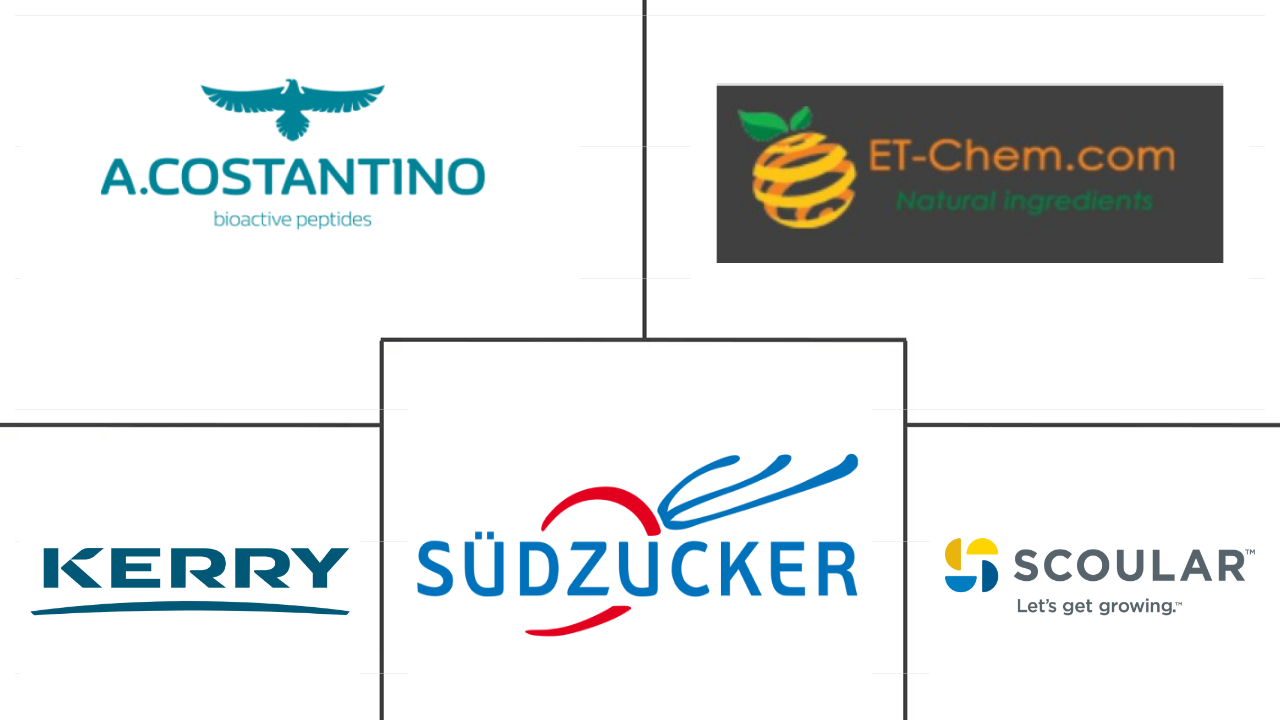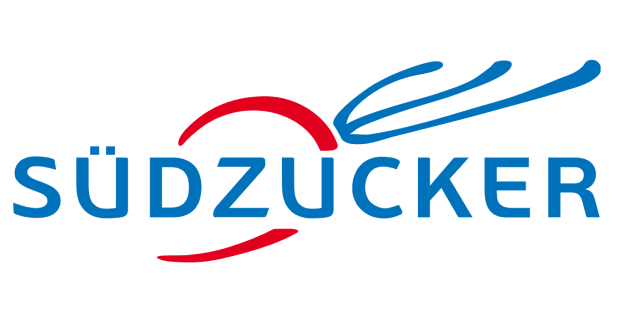Market Size of rice protein Industry
|
|
Study Period | 2017 - 2029 |
|
|
Market Size (2024) | USD 0.81 Billion |
|
|
Market Size (2029) | USD 1.01 Billion |
|
|
Largest Share by End User | Food and Beverages |
|
|
CAGR (2024 - 2029) | 4.30 % |
|
|
Largest Share by Region | Asia-Pacific |
Major Players |
||

|
||
|
*Disclaimer: Major Players sorted in no particular order |
Rice Protein Market Analysis
The Rice Protein Market size is estimated at 0.81 billion USD in 2024, and is expected to reach 1.01 billion USD by 2029, growing at a CAGR of 4.30% during the forecast period (2024-2029).
0.81 Billion
Market Size in 2024 (USD)
1.01 Billion
Market Size in 2029 (USD)
4.34 %
CAGR (2017-2023)
4.30 %
CAGR (2024-2029)
Largest Market by Form
55.56 %
value share, Isolates, 2023
Rice protein isolates hold the largest market share due to the increasing demand for rice bran protein isolates that consist of 92% protein, driving the segment's growth.
Largest Market by End User
96.08 %
value share, Food and Beverages, 2023
Rice protein application in the F&B sector is rising as it is an allergen-friendly alternative to soy and animal dairy proteins, mainly as meat alternatives and in beverages.
Fastest Growing Market by Form
5.14 %
Projected CAGR, Textured/Hydrolyzed, 2024-2029
The rising demand for hydrolyzed rice protein for its application in skin and hair care products, aided by its ability to bind moisture, is fostering the segment's growth.
Fastest Growing Market by End User
5.75 %
Projected CAGR, Supplements, 2024-2029
The features of rice protein, like increasing skin elasticity, conditioning, and source of amino acids, have led manufacturers to enhance their products with rice protein.
Leading Market Player
19.22 %
market share, Südzucker AG, 2021

Suedzucker AG is the market leader in the country due to its exceptional supplying facility of rice proteins and the limited number of competitors in the market.
Growing lactose-intolerant population, globally and increasing protein consumption need is driving the use of rice protein
- Food and beverages remained the largest consumer of rice protein, among other end-user segments. The share was majorly influenced by meat and meat alternatives, which accounted for 82.82% of the rice protein volume consumed in 2022. Rice protein, mainly in the isolates form, has the ability to match meat protein content, which is driving its demand in the segment. Rice protein meets a variety of customer demands, including vegan, gluten-free, and high-protein food products. Rice proteins were used as meat extenders at various concentrations (3%, 6%, 9%, and 12%) in creating chicken nuggets, sausages, patties, and various other products.
- The sports and performance nutrition sub-segment drove the segment in the studied period and is projected to register the fastest CAGR of 5.99% during the forecast period. In 2021, the total market size of the global fitness club industry was over USD 87 billion. There are over 200,000 health and fitness clubs around the world. Rice proteins help strengthen the body's metabolism and regulate sugar levels. It helps to maintain the fitness of the body as rice proteins help to burn fats and improves the hydration of the skin cell.
- People with lactose intolerance are becoming more familiar with the component because it is hypoallergenic and a nutritional substitute. In 2021, the number of lactose-intolerant people in the world was around 68%, which led to high demand for alternative proteins, including rice protein. Since polished rice protein has an 86–90% human digestion rate, rice-based formulas have been used as a better soy milk substitute for kids with cow's milk allergies.
With increasing demand for protein supplements and intolerance to animal proteins, North America witnessed a growth in the market for rice protein in recent years
- Asia-Pacific is the leading market for rice protein globally due to its large consumer base and huge production volume. China, India, Bangladesh, and Indonesia are some of the leading rice-producing countries in Asia-Pacific. Since the consumption of rice products is high in the region owing to its cost-effectiveness. In 2021, China produced around 212.84 million metric tons of rice. However, the country is projected to increase its rice production at the fastest rate, with a CAGR of 4.8%, by volume, during the forecast period.
- By form, isolates led the market in the F&B segment with an estimated Y-o-Y growth rate of 1.82% by volume in 2022. The demand for brown rice protein from organic sources is rising relative to white rice in the regional market, particularly in APAC and Europe. However, with the rising lifestyle health disorders, such as diabetes, the demand for hormonal disbalance organic protein surged. France had the highest prevalence of diabetes in Europe (25.2%).
- Due to the increasing demand for protein supplements and intolerance to animal proteins in North America, consumers are switching more frequently to vegan diets, driving the rice protein market. The increasing popularity of veganism can be attributed to Americans' awareness of the negative environmental impact of animal-based diets. This has surged the rice protein market with a volume share of 10.87% in 2022.
- The Middle East is projected to record the highest CAGR of 5.05%, by value, during the forecast period. The growth is due to the outbreak of the COVID-19 pandemic, due to which consumption patterns changed as people prefer having protein in fortified and functional products to increase their nutritional intake.
Rice Protein Industry Segmentation
Concentrates, Isolates, Textured/Hydrolyzed are covered as segments by Form. Food and Beverages, Personal Care and Cosmetics, Supplements are covered as segments by End User. Africa, Asia-Pacific, Europe, Middle East, North America, South America are covered as segments by Region.
- Food and beverages remained the largest consumer of rice protein, among other end-user segments. The share was majorly influenced by meat and meat alternatives, which accounted for 82.82% of the rice protein volume consumed in 2022. Rice protein, mainly in the isolates form, has the ability to match meat protein content, which is driving its demand in the segment. Rice protein meets a variety of customer demands, including vegan, gluten-free, and high-protein food products. Rice proteins were used as meat extenders at various concentrations (3%, 6%, 9%, and 12%) in creating chicken nuggets, sausages, patties, and various other products.
- The sports and performance nutrition sub-segment drove the segment in the studied period and is projected to register the fastest CAGR of 5.99% during the forecast period. In 2021, the total market size of the global fitness club industry was over USD 87 billion. There are over 200,000 health and fitness clubs around the world. Rice proteins help strengthen the body's metabolism and regulate sugar levels. It helps to maintain the fitness of the body as rice proteins help to burn fats and improves the hydration of the skin cell.
- People with lactose intolerance are becoming more familiar with the component because it is hypoallergenic and a nutritional substitute. In 2021, the number of lactose-intolerant people in the world was around 68%, which led to high demand for alternative proteins, including rice protein. Since polished rice protein has an 86–90% human digestion rate, rice-based formulas have been used as a better soy milk substitute for kids with cow's milk allergies.
| Form | |
| Concentrates | |
| Isolates | |
| Textured/Hydrolyzed |
| End User | ||||||||
| ||||||||
| Personal Care and Cosmetics | ||||||||
|
| Region | |||||||||||||||||
| |||||||||||||||||
| |||||||||||||||||
| |||||||||||||||||
| |||||||||||||||||
| |||||||||||||||||
|
Rice Protein Market Size Summary
The rice protein market is experiencing steady growth, driven by its increasing application in the food and beverage industry, particularly in meat and meat alternatives. This demand is largely due to rice protein's ability to match the protein content of meat, making it an attractive option for vegan, gluten-free, and high-protein products. The sports and performance nutrition segment is also contributing to this growth, as rice protein is recognized for its benefits in metabolism and sugar regulation. The market is further bolstered by the rising awareness and demand for alternative proteins among lactose-intolerant individuals and those seeking plant-based diets, particularly in regions like North America and Europe. The Asia-Pacific region, with its significant rice production and consumption, remains a key player in the global rice protein market.
The market landscape is characterized by a fragmented structure, with major companies like A. Costantino & C. spa, ETChem, Kerry Group plc, Südzucker AG, and The Scoular Company holding significant shares. These companies are actively expanding their product offerings to include a broader range of plant-based protein solutions, catering to the growing consumer preference for vegan and allergen-free products. The Middle East is projected to witness the highest growth rate, driven by changing dietary preferences and increased consumption of fortified and functional products. As global awareness of the health, environmental, and ethical benefits of plant-based diets continues to rise, the rice protein market is poised for further expansion, supported by ongoing innovations and strategic acquisitions within the industry.
Rice Protein Market Size - Table of Contents
-
1. MARKET SEGMENTATION (includes market size in Value in USD and Volume, Forecasts up to 2029 and analysis of growth prospects)
-
1.1 Form
-
1.1.1 Concentrates
-
1.1.2 Isolates
-
1.1.3 Textured/Hydrolyzed
-
-
1.2 End User
-
1.2.1 Food and Beverages
-
1.2.1.1 By Sub End User
-
1.2.1.1.1 Bakery
-
1.2.1.1.2 Beverages
-
1.2.1.1.3 Meat/Poultry/Seafood and Meat Alternative Products
-
1.2.1.1.4 Snacks
-
-
-
1.2.2 Personal Care and Cosmetics
-
1.2.3 Supplements
-
1.2.3.1 By Sub End User
-
1.2.3.1.1 Elderly Nutrition and Medical Nutrition
-
1.2.3.1.2 Sport/Performance Nutrition
-
-
-
-
1.3 Region
-
1.3.1 Africa
-
1.3.1.1 By Form
-
1.3.1.2 By End User
-
1.3.1.3 By Country
-
1.3.1.3.1 Nigeria
-
1.3.1.3.2 South Africa
-
1.3.1.3.3 Rest of Africa
-
-
-
1.3.2 Asia-Pacific
-
1.3.2.1 By Form
-
1.3.2.2 By End User
-
1.3.2.3 By Country
-
1.3.2.3.1 Australia
-
1.3.2.3.2 China
-
1.3.2.3.3 India
-
1.3.2.3.4 Indonesia
-
1.3.2.3.5 Japan
-
1.3.2.3.6 Malaysia
-
1.3.2.3.7 New Zealand
-
1.3.2.3.8 South Korea
-
1.3.2.3.9 Thailand
-
1.3.2.3.10 Vietnam
-
1.3.2.3.11 Rest of Asia-Pacific
-
-
-
1.3.3 Europe
-
1.3.3.1 By Form
-
1.3.3.2 By End User
-
1.3.3.3 By Country
-
1.3.3.3.1 Belgium
-
1.3.3.3.2 France
-
1.3.3.3.3 Germany
-
1.3.3.3.4 Italy
-
1.3.3.3.5 Netherlands
-
1.3.3.3.6 Russia
-
1.3.3.3.7 Spain
-
1.3.3.3.8 Turkey
-
1.3.3.3.9 United Kingdom
-
1.3.3.3.10 Rest of Europe
-
-
-
1.3.4 Middle East
-
1.3.4.1 By Form
-
1.3.4.2 By End User
-
1.3.4.3 By Country
-
1.3.4.3.1 Iran
-
1.3.4.3.2 Saudi Arabia
-
1.3.4.3.3 United Arab Emirates
-
1.3.4.3.4 Rest of Middle East
-
-
-
1.3.5 North America
-
1.3.5.1 By Form
-
1.3.5.2 By End User
-
1.3.5.3 By Country
-
1.3.5.3.1 Canada
-
1.3.5.3.2 Mexico
-
1.3.5.3.3 United States
-
1.3.5.3.4 Rest of North America
-
-
-
1.3.6 South America
-
1.3.6.1 By Form
-
1.3.6.2 By End User
-
1.3.6.3 By Country
-
1.3.6.3.1 Argentina
-
1.3.6.3.2 Brazil
-
1.3.6.3.3 Rest of South America
-
-
-
-
Rice Protein Market Size FAQs
How big is the Global Rice Protein Market?
The Global Rice Protein Market size is expected to reach USD 814.96 million in 2024 and grow at a CAGR of 4.30% to reach USD 1.01 billion by 2029.
What is the current Global Rice Protein Market size?
In 2024, the Global Rice Protein Market size is expected to reach USD 814.96 million.

